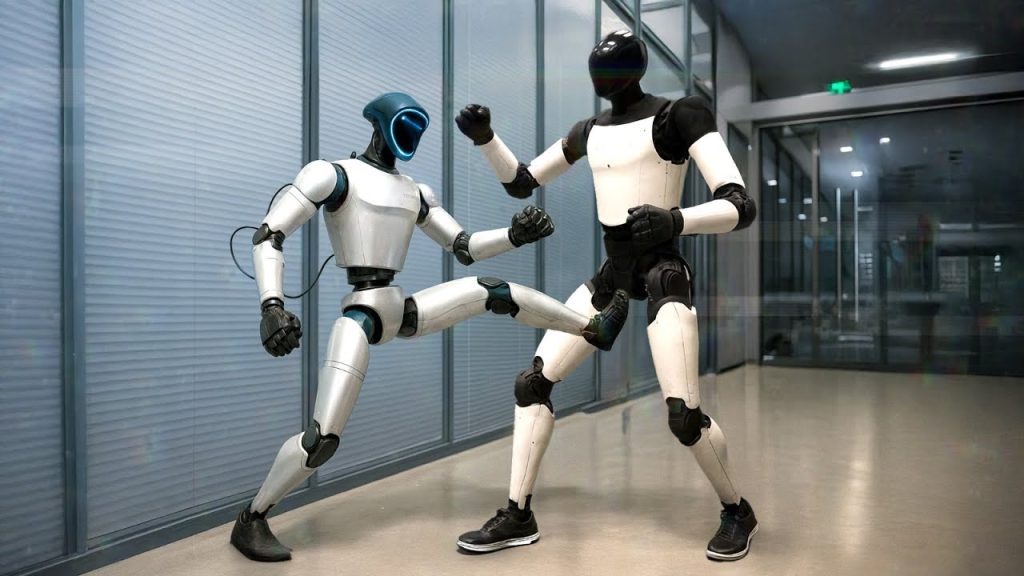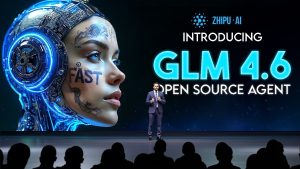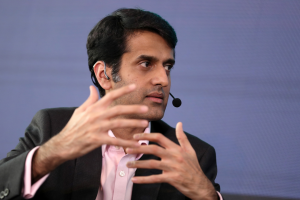AI Robot Conflict Erupts: Optimus Gen 3 Faces Off Against Enhanced Unitree G1

The Rise of Humanoid Robots: A Comparative Analysis of Tesla’s Optimus and Unitree’s G1
The internet has been abuzz with excitement over two new humanoid robot clips that have recently emerged: Tesla’s Optimus and Unitree’s G1. Both robots showcase fascinating capabilities, but they represent different philosophies and approaches within the robotics field. This breakdown will compare their latest performances, technological advancements, and the broader implications for the future of robotics.
Tesla’s Optimus: A Leap Toward Realism
In its latest demonstration, Tesla’s Optimus showcased movements that felt much more natural and close to real-time behavior compared to previous sped-up clips. The robot mirrored a human partner and displayed visible coordination between its upper and lower body while responding to simulated attacks. While the performance wasn’t flawless, it clearly exhibited an evolution in control, being driven entirely by onboard AI rather than a remote operator. This self-reliance is a significant milestone, indicating that Optimus is capable of making decisions based on sensor data rather than simply following a scripted routine.
The demo transitioned from basic movement and slow footwork to more complex maneuvers like defensive blocks and repositioning. For the first time, Optimus appeared to grasp elements of rhythm and weight transfer. However, a limitation was noticeable: the hands remained stiff, likely due to an unavailability of the promised finger movement upgrade.
Unitree’s G1: Resilience and Recovery
In stark contrast, Unitree’s G1 video prioritized resilience over elegance. The robot was literally pushed, kicked, and knocked down, yet it consistently managed to bounce back. Branded as “anti-gravity mode,” this performance demonstrated G1’s impressive ability to anticipate impacts and adjust its weight accordingly. After each fall, the G1 analyzed its movements, re-established its balance, and stood back up independently.
This impressive capability is made possible by the multitude of sensors packed into G1’s frame, including depth cameras, LiDAR, and joint torque sensors that facilitate a robust control loop. Rather than relying on rigid responses, G1’s algorithm calculates the optimal way to absorb impacts, allowing for organic movement, much like an athlete would respond in similar situations.
Differences in Market Approach
Elon Musk’s vision for Optimus encompasses deploying thousands of these robots inside Tesla factories by 2025, with ambitious plans to scale production rapidly. If successful, economies of scale could make these robots significantly more affordable. However, the challenge lies in the nature of humanoids; they evolve in complexity more slowly than the automotive production lines Tesla is already familiar with.
Conversely, Unitree has garnered field experience through its already deployed robot dogs in various sectors such as defense and research. Unlike Tesla, Unitree’s G1 is part of a lineage that emphasizes learning through adversity, with engineers rigorously testing and refining the hardware after real-world failures.
Security Concerns and Ethical Considerations
A significant concern arose recently when security researchers discovered a critical Bluetooth vulnerability in Unitree robots, allowing hackers to gain root access. This opens up a potential for compromised units to hijack nearby robots, creating a so-called “walking botnet.” Although the company has announced plans for updates and better security measures, trust remains a crucial issue when robots can connect to the internet and move independently.
In contrast, Tesla’s Optimus does not currently face such severe security vulnerabilities. However, both robots must grapple with the fundamental challenges of robotics: how to maintain reliability, safety, and seamless functionality in unpredictable environments.
Competing Ecosystems in Robotics
This head-to-head competition illustrates a larger rivalry between American and Chinese engineering philosophies. Tesla embodies a vertically integrated model that tightly controls both hardware and software. Its ecosystem is designed for precise performance and safety, but at the cost of slower iteration.
Unitree, on the other hand, adopts an open and fast-paced model that floods the market, gathers feedback, and iterates quickly. This doesn’t just apply to Unitree; companies like Meta and Amazon are also entering the robotics race, demonstrating a shift toward collective innovation and cross-collaboration.
The Challenge of Dexterity
While movement and stability are currently the focus of both robots, the next significant hurdle is the development of dexterous manipulation capabilities. The ability to grasp irregular objects or perform intricate tasks will mark the transition from humanoids being simple machines to truly multifunctional assistants.
As it stands, both Optimus and G1 continue to grow in sophistication. However, neither has yet demonstrated the nuanced hand movements necessary for practical applications in complex environments.
Conclusion: Intelligence vs. Resilience
In summation, both Tesla’s Optimus and Unitree’s G1 are making impressive strides in humanoid robotics, but they embody different philosophies. Tesla aims for smart, efficient machines, while Unitree prioritizes rugged, adaptable robots capable of thriving in real-world chaos.
By focusing on intelligent design, Optimus shows great promise but still operates within controlled conditions. On the other hand, G1 appears closer to practical deployment by excelling in resilience and quick recovery. Although Tesla has enormous potential thanks to its robust AI backing, Unitree’s affordability and adaptability make it a more immediate solution for commercial applications.
In this rapidly evolving field, the gap between demonstration and real-world application is narrowing. Each robot contributes something valuable to the robotics landscape, and as they each push the boundaries in their own ways, the future of labor, safety, and autonomy will undoubtedly transform.
As competition heats up, only time will tell which approach will ultimately prevail, but the exciting advancements in humanoid technology promise to shape numerous industries for years to come.
#Robot #World #War #Begins #Optimus #Gen #Upgraded #Unitree
Thanks for reaching. Please let us know your thoughts and ideas in the comment section.
Source link






First
First.
Yeah. Everyone should stop for a second and wonder how those robots are going to be used seeing who's at the helm. Spoiler: it's not good.
Optimus looks very scripted. The other one does fill contact
I remember when the Honda robot going up stairs was amazing.
ok but when we getting robot girlfriends/boyfriends?
preferably completely local with no telemetry besides downloading personality, configuration files and updates for the AI and software…. But that's a long shot in this world where telemetry is everywhere, right?
Anyone remember metabots/medabots? That old anime from childhood?
,.,
I won't be really happy with robotics progress as long as robots can't do my laundry and other house chores
Shiney cool thing side of my brain brain, big excited. Logic brain side, HAVE WE LEARNED NOTHING FROM DECADES OF SCIFI MOVIES 💀
I want to see Optimus handle nunchucks!
but… but… but AI can never replace humans. Humans have souls. That robot doesn't-
-says every AI Denier